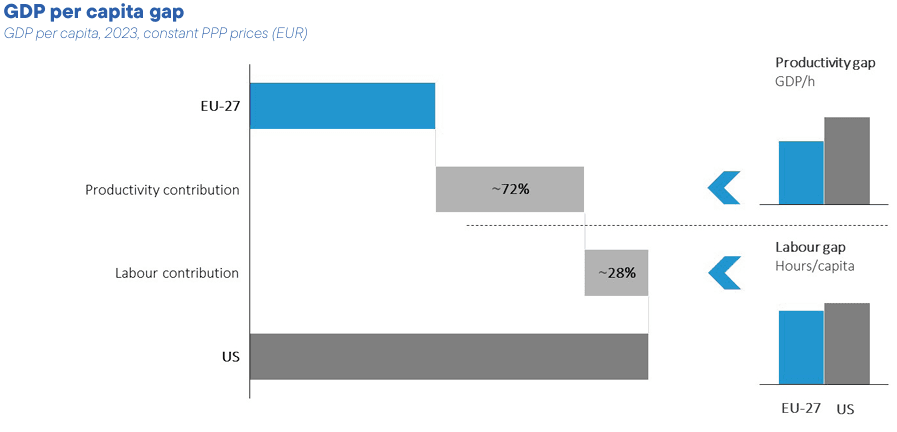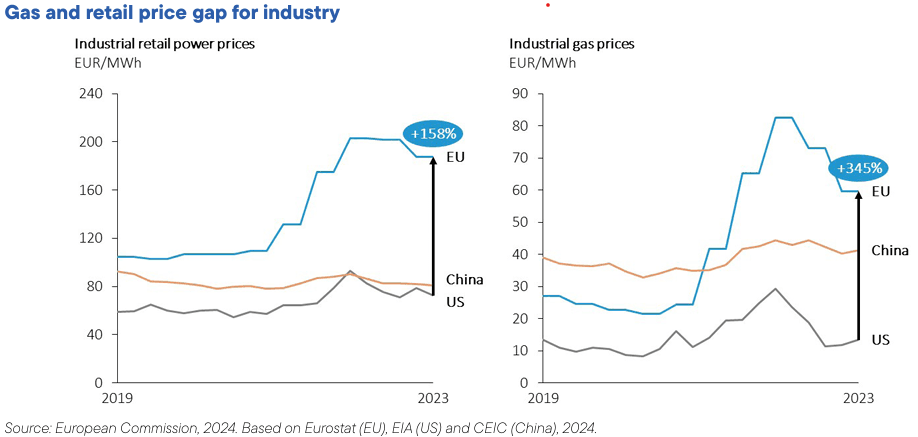24/09/2024
The Draghi Report and the EU’s Multiannual Financial Framework
Newsletter #73 - September 2024
EU citizens recognize that Draghi has a point
When crossing internal EU borders, many of us experience disruption to our mobile phone connections as we switch from one national network to another. This issue is quite perplexing, given that the infrastructure for mobile networks is largely the same across the EU.
Without consciously realizing it, most EU citizens - especially those who have crossed an internal border - are aware of the structural inefficiencies that persist within the EU. These challenges are highlighted in the Draghi Report.
The Fundamental Issue
Despite its name, the European Union is, in many respects, still far from a unified entity. As the example of mobile networks shows, the EU continues to function more like a collection of individual nations rather than a seamless region with standardized rules and regulations. This fragmented approach affects numerous sectors, limiting the EU’s potential for cohesion and growth.
One of the significant consequences of this fragmentation is the EU’s lower productivity compared with the United States, which directly impacts the overall wealth of EU member states. As shown in Figure 1, the Draghi Report estimates that 72% of the GDP per capita gap between the EU and the US can be attributed to this productivity shortfall.
Productivity and Labour Shortfalls
Additionally, approximately 28% of the GDP gap arises from the fact that fewer hours are worked per capita in the EU compared with the US.
Figure 1 GDP per capita comparison source Draghi Report p 9

If the EU fails to close this productivity gap, it will struggle to generate the growth needed to sustain its social welfare programs. This challenge becomes even more pressing given that, by 2040, the EU’s workforce is projected to shrink by nearly two million workers annually.
Without significant structural reforms, EU countries may soon find it impossible to support their current social welfare systems.
Key Areas of Focus
Closing the innovation gap with the US and China
The Draghi Report highlights a critical issue within the EU's industrial landscape:
“Europe is stuck in a static industrial structure with few new companies rising up to disrupt existing industries or develop new growth engines.”
This stagnation is largely due to insufficient corporate investments in research and innovation (R&I). The EU’s top investors in R&I remain concentrated in the automotive industry, an indicator of the region's reluctance to progress and diversify. The report emphasizes that "Europe cannot afford to remain stuck in the 'middle technologies and industries' of the previous century."
In simpler terms, Europe’s industrial policies must move beyond catering to the automotive industry’s needs of Germany and France. The continent boasts talent, skills and innovative ideas, but these are often stifled before reaching commercialization.
A unified plan for decarbonisation and competitiveness
EU energy prices remain prohibitively high, hampering competitiveness. As the region works toward decarbonization, energy costs must be reduced. The EU holds a competitive edge in developing clean technologies, but the report warns that fossil fuels will still play a role for the foreseeable future.
Figure 2 Energy prices in EU, US and China source Draghi report p 11

European industries simply cannot compete with the US and China at current energy price differentials. The longer it takes for the EU to transition towards renewable and nuclear energy and ensure availability where needed, the longer Europe will lag behind its global competitors.
Defence and security
Europe can no longer rely on external powers for its security. The “peace dividend” enjoyed after the Cold War has been exhausted, and substantial investment in defence is now required.
For decades, European defence industries have suffered from underinvestment due to uncertainty and lack in government procurement. Moving forward, Europe must prioritize defence spending and invest in strategically important sectors, such as semiconductors and clean technologies, to build domestic production capacity. Currently, the EU is overly dependent on the US and Southeast Asia in these critical areas, a situation that is unsustainable in the current geopolitical climate.
Recommended Action Points
The Draghi Report outlines a comprehensive set of recommendations aimed at enhancing the EU's economic growth potential. These recommendations fall into two broad categories:
Full Single Market Implementation with Multiple “Unions”
1. Implementing the single market completely
A priority for the EU is the full implementation of the single market for both goods and services. Currently, while goods benefit from the single market, services lag behind. A more integrated approach is necessary to unlock growth across all sectors.
2. Establishing an energy union
To lower energy costs, the EU must form an "energy union," which would transform individual national energy markets into a unified EU-wide market. This would strengthen the EU's negotiating power when purchasing energy as a single entity. Additionally, renewable energy prices should be decoupled from fossil fuel prices, especially gas. Investments in renewable energy and nuclear power are vital, but the focus must also be on upgrading and expanding energy grids.
One proposal in this framework is the creation of a "28th regime" - a special legal structure that would supersede national laws for critical infrastructure projects, such as energy interconnectors.
3. Completing the banking union
Bank loans remain the most common form of external financing for companies in Europe, but European banks struggle to finance innovative businesses due to a lack of expertise and insufficient scale. To address this, the Draghi Report calls for the completion of the EU banking union, including the establishment of a separate jurisdiction for banks with significant cross-border operations. This would introduce a "country-blind" regulatory, supervisory and crisis management approach. This recommendation challenges national interests, particularly the German banking model.
4. Creating a capital market union
Another critical recommendation is the creation of a capital market union. The EU does not yet have a single market for securities with uniform rules and regulations. Processes like clearing and trade settlements remain fragmented compared with the US.
Investment in the EU is overly reliant on bank financing and lacks the long-term capital crucial for research and innovation. The Draghi Report points out that EU pension assets amounted to just 32% of GDP in 2022, compared with 142% in the US. Notably, three countries (Denmark, the Netherlands, and Sweden) account for 62% of these assets; in most other EU countries, pension wealth is tied to public social security systems (pay-as-you-go). The report suggests that while European households save enough, capital is not being directed to the most productive investments.
Increasing public and private investment
The Draghi Report also focuses on the massive investment required to drive growth:
- an additional EUR 750-800 billion of investments annually
- this equates to 4.4-4.7% of GDP (more than twice the size of the Marshall Plan)
- raising public capital at the EU level by issuing bonds.
According to the report, 80% of these investments would come from the private sector, while the remaining 20% would be public investments. Draghi recommends raising capital at the EU level to support research, innovation and necessary infrastructure projects. Additionally, the size and allocation of the Multiannual Financial Framework (MFF) should be reassessed, as the EU's current budget stands at only 1% of GDP, or roughly EUR 180 billion annually.
Multiannual Financial Framework (MFF) 2028
The MFF refers to the EU's seven-year budget framework, currently running from 2021 to 2027. The Draghi Report serves as a roadmap for the upcoming MFF negotiations, which are set to begin around mid-2025. The report highlights that required investments in Europe are constrained not just by capital market fragmentation, but also by the limitations of the EU budget and the planned repayment of NextGenerationEU bonds.
The current MFF allocates 30.5% to cohesion policies and 30.9% to the Common Agricultural Policy, areas the Draghi Report suggests need reform. In future budgets, funding should be redirected toward strategic priorities such as infrastructure, research and innovation.
If the current distribution persists, EUR 60 billion will be spent on agriculture, another EUR 60 billion on cohesion, and EUR 30 billion on debt repayment, leaving just EUR 30-40 billion for other critical needs, including defence.
Reallocation of the EU budget
Without being explicit, the Draghi Report indicates that, to free up funds for other priorities, the budget for the Common Agricultural Policy must be significantly changed and funds reduced. Cohesion funds in their current form are unsustainable, and the Draghi Report suggests that they should be redirected toward projects that integrate the EU, such as energy interconnectors, rather than national projects with limited impact.
Battle of the budget
These proposed reforms will face strong resistance. Countries like France and Poland are likely to oppose cuts to agricultural spending, while Eastern and Southern European nations may resist reductions in cohesion funds. At the same time, Northern European countries, including Germany and the Netherlands, have already expressed opposition to issuing more EU debt. Nevertheless, most countries agree on the need for increased spending on defence, security and border protection. This upcoming "battle of the budget" will be a crucial turning point for the EU, which often requires a crisis to spur change. With an aging workforce projected to shrink by 2 million annually by 2040, the time for reform is now.
Medium-term impact for investors
If the Draghi Report recommendations are implemented, the impact on investors will be significant and positive. More efficient capital markets could reduce costs for retail and institutional investors, but the biggest gains would be seen in EU equity markets, which have considerable potential to catch up to their US counterparts.
Cross-border consolidation in the financial sector is expected to be one of the first outcomes, while companies involved in infrastructure and decarbonization solutions will also benefit from these reforms. Over time, European energy-intensive industries will regain competitiveness, and new, innovative companies will emerge, potentially transforming the EU economy.
The EU could certainly use a "Google" or two of its own going forward.
Links to the Draghi report:
The Draghi Report - The future of European competitiveness - Part A
The Draghi Report - The future of European competitiveness - Part B